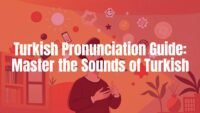People often wonder if Turkish is a hard language to learn. The truth is, Turkish isn’t especially difficult in itself, but it is very different from English and many other European languages. Turkish comes from the Turkic language family, so its grammar, words, and general logic can feel unfamiliar. But this difference doesn’t mean it’s too hard to learn. In fact, many rules in Turkish are regular and make sense once you get used to them. This article explains what can be tough about Turkish for English speakers, what actually makes it easier, how it compares to other languages, and gives simple advice for learning Turkish.

What Makes Turkish Language Difficult for Learners?
Although Turkish doesn’t have to be hard, its unique features can feel unfamiliar, especially for English speakers. Most of the challenges come from differences in language structure and historical origins.
Turkish Grammar Structure
Turkish grammar looks and works differently from English. English makes heavy use of prepositions and little helper words. Turkish joins lots of endings (called suffixes) onto root words, a method called “agglutination.” These endings add meaning like tense, person, or possession. Sometimes, what would be a whole sentence in English is just one long word in Turkish. While this seems complicated at first, there aren’t many surprises, and rules are steady once you learn them.
- English: I am at your service
- Turkish: Hizmetinizdeyim
Agglutination and Suffixes
Turkish is famous for stacking suffixes onto root words, a bit like snapping Lego blocks together. Each suffix adds a piece of information, like “who,” “when,” or “how many.” You use endings instead of extra words for things like tense and possession. This may look difficult, but it’s actually quite logical once you know the pattern. It also means you can build lots of new words using known pieces.

Pronunciation and New Sounds
Turkish spelling is easy to learn because it’s phonetic – words sound just like they are written. But several sounds and letters are new for English speakers:
| Letter | How to Say It | English Example |
|---|---|---|
| Ç | ch | “ch” in “chair” |
| Ş | sh | “sh” in “shell” |
| I (no dot) | uh | Like the “a” in “sofa” |
| Ğ | soft, lengthens vowel | – |
| Ö, Ü | rounded front vowels | Similar to German “ö,” “ü” |
Getting these sounds right is important and may take some practice.
Vowel Harmony
When adding suffixes in Turkish, the vowels in the ending must “match” the vowels in the main word. Turkish has eight main vowels, split into different groups. The rule is: the last vowel in the root word decides what kind of vowel appears in the suffix. This makes words easier to pronounce smoothly. Learning vowel harmony takes a little time but it’s consistent and soon becomes automatic.
- If the last vowel is ‘a’ or ‘ı’ → use ‘a’ or ‘ı’ in suffix
- If the last vowel is ‘e’ or ‘i’ → use ‘e’ or ‘i’ in suffix
Differences from English and Indo-European Languages
Turkish and English are not closely related. Turkish has its own roots, while English connects to Germanic and other Western European languages. This means the basic rules, word order, and vocabulary can feel completely new. For example, Turkish uses Subject-Object-Verb word order, so the verb usually comes last:
- English: Mary eats an apple
- Turkish: Mary bir elma yiyor (Mary an apple eats)
This setup takes some getting used to if you’re used to English patterns.
Learning Turkish Vocabulary
Most everyday Turkish words aren’t anything like the ones in English, so you can’t depend on similar-sounding words (cognates) as shortcuts. While there are some borrowed words from Arabic, Persian, French, and English, most Turkish words must simply be learned. The good part is the spellings are steady, so once you know the sounds, new words are easier to remember. Learning a base word can also help you understand other forms, thanks to suffixes.
What Makes Turkish Easy to Learn?
While Turkish does have some unique points, these features can actually help you learn the language more quickly and make the process less stressful.
Latin Alphabet
Turkish uses a Latin alphabet, like English. This was adopted in 1928 and means you don’t have to learn a new script. While there are extra letters (Ç, Ş, Ğ, I, Ö, Ü) and a few missing (Q, W, X), seeing familiar letters makes starting to read and write Turkish less of a challenge.
Phonetic Spelling
Turkish words almost always sound like they are written. One letter, one sound – and almost no odd exceptions. If you can read it, you can say it. This is very different from English, where the same letter can mean lots of different sounds (compare “cough” and “through”).

No Grammatical Gender or Articles
Turkish doesn’t have male or female words like French or Spanish. There are also no separate words for “the” or “a/an” – that is, no definite or indefinite article. This means you don’t have to memorize extra rules for gender or articles and can focus more on the core meaning of sentences.
Regular patterns in Grammar
Turkish grammar rules almost never have exceptions. Once you know a rule, you can use it everywhere. This is very helpful if you struggle to remember all the “irregular” verbs in other languages. This system lets you build and understand new words easily, much like fitting puzzle pieces together.
How Does Turkish Compare to English and Other Languages?
Looking at how Turkish lines up with English and other languages can give you a better idea of what to expect.
Is Turkish Related to English?
Not really. Turkish is in the Turkic family; English is Germanic (with lots of words from Latin and French). The two languages don’t share much grammar or vocabulary. It takes longer to learn Turkish than to learn, for example, Spanish or French, which are more similar to English. Both Turkish and English use the Latin alphabet, though, which helps a little.
Comparisons with European Languages
Most European languages (like German, Spanish, or Italian) are related to English, so they often share some words and grammar ideas. Turkish stands out because of its agglutinative system, lack of grammatical gender, and its Subject-Object-Verb word order. Hungarian and Finnish, although not related, also use a similar kind of structure. If you know Korean or Japanese, you might spot a few familiar ideas (like how to use suffixes or sentence order).
Sentence Structure in Turkish
In Turkish sentences, the verb always goes at the end, so you may have to wait until the last word to understand what’s happening. While this isn’t usual in English, Turkish also allows for some changes in word order to change the focus of a sentence, which gives the speaker some freedom as they speak.
How Long Does It Take to Learn Turkish?
The time needed to learn Turkish is different for each person, but there are some general guidelines.
FSI Language Ranking
The U.S. Foreign Service Institute (FSI) puts Turkish in Category IV: a language that takes about 1,100 hours of learning to reach good working proficiency for an English speaker. That’s more time than you’d spend on, say, French or Spanish (500-600 hours), but less than you’d need for Arabic, Chinese, or Japanese (often 2,200 hours or more).
| Language | FSI Category | Estimated Hours |
|---|---|---|
| French/Spanish | I | 500-600 |
| German | II | 750 |
| Turkish | IV | 1,100 |
| Chinese/Arabic/Japanese | V | 2,200+ |
What Affects How Fast You Learn?
- Your experience with learning other languages, especially those with similar grammar (like Japanese or Korean)
- Your motivation and reason for learning Turkish
- The methods and tools you use
- How much you listen and speak to real people in Turkish
- How much time you spend learning every day or week

How Long to Reach Basic and Advanced Levels?
If you study a few hours a week, basic conversations could be possible after a few months. Reaching a level where you can discuss many topics without much trouble might take about two years, especially if you’re learning outside Turkey. Immersing yourself in a Turkish environment, like living or studying in Turkey, can make your progress much, much faster.
Common Myths about Turkish Language Difficulty
Some people think Turkish is one of the hardest languages on earth, but this isn’t accurate.
Is Turkish Among the Hardest?
While Turkish is tougher than some European languages, it’s not usually listed as one of the hardest. Arabic, Chinese, Japanese, and Korean are all generally ranked as more challenging for English speakers, often because they use different writing systems or have many irregular grammar rules.
Thoughts About Turkish Grammar and Vocabulary
Some believe Turkish grammar is full of tricky exceptions. In fact, Turkish rules are steady and reliable. People also think all Turkish words are totally foreign. Actually, Turkish has taken in many words from Arabic, Persian, and French. If you know one of those languages, you might find many words that are familiar. The challenge is simply that there aren’t as many common words as you’d see between English and, for example, Spanish or French.
Simple Tips for Learning Turkish
Start with the Alphabet
Spend extra time learning the Turkish letters and practicing their sounds, especially the ones that do not appear in English. Being able to pronounce words correctly from the beginning will help you out a lot.
Practice Suffixes and Vowel Harmony
Learn the main suffixes and how vowel harmony works. Try splitting long words into root + pieces to see how their meanings are made. With time, this becomes much simpler and you’ll start to piece together words easily.
Grow Your Vocabulary
- Focus on the most common words first
- Use flashcards or spaced-repetition apps
- Practice reading simple Turkish stories or blogs
- Write down and review new words often
Use Language Learning Apps
Programs like OptiLingo, Babbel, or TurkishClass101 offer organized lessons and practice for pronunciation, listening, and vocabulary. Pick apps or websites that teach basic words and grammar and allow for lots of practice.
Watch and Listen to Turkish Content
- Watch Turkish TV series or movies
- Listen to Turkish music or radio
- Find simple Turkish videos on YouTube

Hearing real Turkish often helps you get used to natural speech and current expressions.
Practice Speaking
- Try to speak Turkish with native speakers, online or in person
- Join language exchange groups
- Practice out loud, even if only to yourself
Frequently Asked Questions about Turkish Language Difficulty
Is Turkish hard for English speakers?
Compared to Spanish or French, Turkish will take more time for most English speakers. The different grammar (lots of suffixes, verb at the end) and lack of related vocabulary add extra steps, but Turkish is very logical and follows its rules, making it easier over time. The Foreign Service Institute puts it in the “challenging but possible” category, below the hardest group.
What’s easiest and what’s hardest in Turkish?
- Easiest: Consistent spelling and pronunciation, Latin alphabet, no gender or separate articles
- Hardest: Getting used to long words with many suffixes, learning vowel harmony, and adapting to verb-last word order
While Turkish may seem strange at first, its steady rules and logical setup mean steady practice will help you quickly improve.














Leave a comment